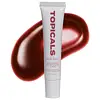What's inside
What's inside
 Key Ingredients
Key Ingredients

 Benefits
Benefits

 Concerns
Concerns

 Ingredients Side-by-side
Ingredients Side-by-side

Hydrogenated Polyisobutene
EmollientPolybutene
Jojoba Esters
EmollientCocos Nucifera Oil
MaskingHelianthus Annuus Seed Oil
EmollientEthylene/Propylene/Styrene Copolymer
Copernicia Cerifera Wax
Butylene/Ethylene/Styrene Copolymer
Glycerin
HumectantSodium Hyaluronate
HumectantHydrolyzed Sodium Hyaluronate
Skin ConditioningCeramide NP
Skin ConditioningCeramide AP
Skin ConditioningCeramide EOP
Skin ConditioningPhytosphingosine
Skin ConditioningPalmitoyl Tripeptide-38
Skin ConditioningCholesterol
EmollientTocopheryl Acetate
AntioxidantErgothioneine
AntioxidantStevia Rebaudiana Leaf/Stem Powder
Skin ConditioningPortulaca Pilosa Extract
Skin ConditioningSucrose Cocoate
EmulsifyingPanthenol
Skin ConditioningSodium Lauroyl Lactylate
EmulsifyingSilica
AbrasiveCarbomer
Emulsion StabilisingKaolin
AbrasiveOryza Sativa Bran Wax
Skin ConditioningXanthan Gum
EmulsifyingDimer Dilinoleyl Dimer Dilinoleate
EmollientTriisostearin
Skin ConditioningCetearyl Ethylhexanoate
EmollientOctyldodecanol
EmollientSorbitan Isostearate
EmulsifyingSorbitan Oleate
EmulsifyingWater
Skin ConditioningAroma
CI 77742
Cosmetic ColorantCI 17200
Cosmetic ColorantCI 45380
Cosmetic ColorantCI 77491
Cosmetic ColorantCI 77499
Cosmetic ColorantCI 77891
Cosmetic ColorantHydrogenated Polyisobutene, Polybutene, Jojoba Esters, Cocos Nucifera Oil, Helianthus Annuus Seed Oil, Ethylene/Propylene/Styrene Copolymer, Copernicia Cerifera Wax, Butylene/Ethylene/Styrene Copolymer, Glycerin, Sodium Hyaluronate, Hydrolyzed Sodium Hyaluronate, Ceramide NP, Ceramide AP, Ceramide EOP, Phytosphingosine, Palmitoyl Tripeptide-38, Cholesterol, Tocopheryl Acetate, Ergothioneine, Stevia Rebaudiana Leaf/Stem Powder, Portulaca Pilosa Extract, Sucrose Cocoate, Panthenol, Sodium Lauroyl Lactylate, Silica, Carbomer, Kaolin, Oryza Sativa Bran Wax, Xanthan Gum, Dimer Dilinoleyl Dimer Dilinoleate, Triisostearin, Cetearyl Ethylhexanoate, Octyldodecanol, Sorbitan Isostearate, Sorbitan Oleate, Water, Aroma, CI 77742, CI 17200, CI 45380, CI 77491, CI 77499, CI 77891
Bis-Behenyl/Isostearyl/Phytosteryl Dimer Dilinoleyl Dimer Dilinoleate
EmollientHydrogenated Polyisobutene
EmollientTridecyl Trimellitate
EmollientHydrogenated Styrene/Methylstyrene/Indene Copolymer
Diisostearyl Malate
EmollientSimmondsia Chinensis Seed Oil
EmollientMicrocrystalline Wax
Emulsion StabilisingMangifera Indica Seed Butter
Skin ConditioningTheobroma Cacao Seed Butter
EmollientOctyldodecanol
EmollientButyrospermum Parkii Butter
Skin ConditioningSynthetic Wax
AbrasivePolyglyceryl-2 Diisostearate
EmulsifyingSilica Dimethyl Silylate
EmollientParfum
MaskingEthylene/Propylene/Styrene Copolymer
Limnanthes Alba Seed Oil
Skin ConditioningDiethylhexyl Syringylidenemalonate
Skin ProtectingDisteardimonium Hectorite
StabilisingTocopherol
AntioxidantEthylhexylglycerin
Skin ConditioningDipotassium Glycyrrhizate
HumectantGlyceryl Behenate
EmollientPropylene Carbonate
SolventHelianthus Annuus Seed Oil
EmollientHydrolyzed Sodium Hyaluronate
Skin ConditioningPentaerythrityl Tetra-Di-T-Butyl Hydroxyhydrocinnamate
AntioxidantButylene/Ethylene/Styrene Copolymer
Caprylic/Capric Triglyceride
MaskingCI 77891
Cosmetic ColorantCI 77492
Cosmetic ColorantCI 15850
Cosmetic ColorantCI 77499
Cosmetic ColorantCI 77491
Cosmetic ColorantBis-Behenyl/Isostearyl/Phytosteryl Dimer Dilinoleyl Dimer Dilinoleate, Hydrogenated Polyisobutene, Tridecyl Trimellitate, Hydrogenated Styrene/Methylstyrene/Indene Copolymer, Diisostearyl Malate, Simmondsia Chinensis Seed Oil, Microcrystalline Wax, Mangifera Indica Seed Butter, Theobroma Cacao Seed Butter, Octyldodecanol, Butyrospermum Parkii Butter, Synthetic Wax, Polyglyceryl-2 Diisostearate, Silica Dimethyl Silylate, Parfum, Ethylene/Propylene/Styrene Copolymer, Limnanthes Alba Seed Oil, Diethylhexyl Syringylidenemalonate, Disteardimonium Hectorite, Tocopherol, Ethylhexylglycerin, Dipotassium Glycyrrhizate, Glyceryl Behenate, Propylene Carbonate, Helianthus Annuus Seed Oil, Hydrolyzed Sodium Hyaluronate, Pentaerythrityl Tetra-Di-T-Butyl Hydroxyhydrocinnamate, Butylene/Ethylene/Styrene Copolymer, Caprylic/Capric Triglyceride, CI 77891, CI 77492, CI 15850, CI 77499, CI 77491
 Reviews
Reviews

Ingredients Explained
These ingredients are found in both products.
Ingredients higher up in an ingredient list are typically present in a larger amount.
We don't have a description for Butylene/Ethylene/Styrene Copolymer yet.
Ci 77491 is also hydrated iron III oxide. It's sole purpose is to give a red/pink hue to products.
Iron III oxides are classified as inorganic chemicals for coloring.
Synthetically created Ci 77491 is considered safer than those naturally found. This is because the synthetically created version may contain less impurities. Iron oxides are generally non-toxic and non-allergenic.
Learn more about CI 77491Ci 77499 is also hydrated iron III oxide. It is created from mixing red and black iron oxides. This helps give shades of darkness to a product.
Iron III oxides are classified as inorganic chemicals for coloring.
Ci 77891 is a white pigment from Titanium dioxide. It is naturally found in minerals such as rutile and ilmenite.
It's main function is to add a white color to cosmetics. It can also be mixed with other colors to create different shades.
Ci 77891 is commonly found in sunscreens due to its ability to block UV rays.
Learn more about CI 77891We don't have a description for Ethylene/Propylene/Styrene Copolymer yet.
Helianthus Annuus Seed Oil is the oil derived from the seeds of a Sunflower. Sunflower seed oil is non-fragrant. It is an emollient, meaning it helps to soften the skin.
Sunflower seed oil contains many fatty acids. The fatty acids found in sunflower seeds include (from highest amount to least): linoleic acid, myristic acid, palmitic acid, stearic acid, arachidic acid, oleic acid, and linolenic acid.
These fatty acids help the skin create ceramides. Ceramides play a role in repairing the skin barrier.
Helianthus Annuus Seed Oil helps moisturize the skin. This in turn helps the skin look more rejuvenated and smoother.
Sunflowers are rich in vitamin E.
Historians believe Indigenous cultures of North America domesticated sunflowers before corn. Thus they relied on sunflower oil for a variety of uses. One such use is moisturizing skin and hair.
Sunflower seed oil may not be fungal acne safe. We recommend speaking with a professional if you have any concerns.
Learn more about Helianthus Annuus Seed OilHydrogenated Polyisobutene is a synthetic polymer. Polymers are compounds with high molecular weight. Hydrogenated Polyisobutene is an emollient and texture enhancer.
In one study, Hydrogenated Polyisobutene showed better skin hydration levels than Caprylic/Capric Triglyceride. As an emollient, it helps keep your skin soft and hydrated by trapping moisture in.
Hydrogenated Polyisobutene is often used as a mineral oil replacement.
Learn more about Hydrogenated PolyisobuteneThis ingredient is created by putting sodium hyaluronate through hydrolysis.
You might know this as 'mini' or 'ultra low-molecular weight' hyaluronic acid. The small molecule size means it is able to travel deeper in the skin.
According to studies, low molecular-weight hyaluronic acid can:
One study from 2011 found ultra-low weight HA to show pro-inflammatory properties. Another study from 2022 found it to downregulate UV-B induced inflammation.
Hydrolysis is a process of changing a molecule using water or enzymes.
This ingredient is water-soluble.
Learn more about Hydrolyzed Sodium HyaluronateOctyldodecanol is a fatty alcohol. It is primarily used to enhance the texture of products.
As an emulsifier, Octyldodecanol helps prevent the oils and waters from separating. It also prevents ingredients from creating foam when shaken.
Octyldodecanol is created by reducing fatty acid to an alcohol.
Due to its high molecular weight, it does not get absorbed into the skin.
Learn more about Octyldodecanol